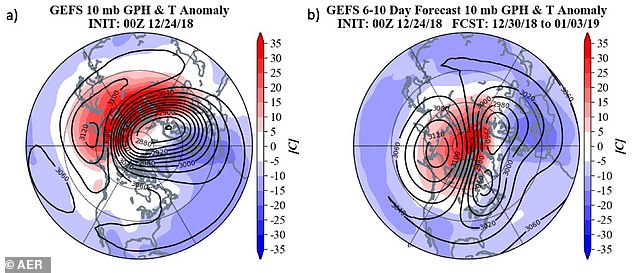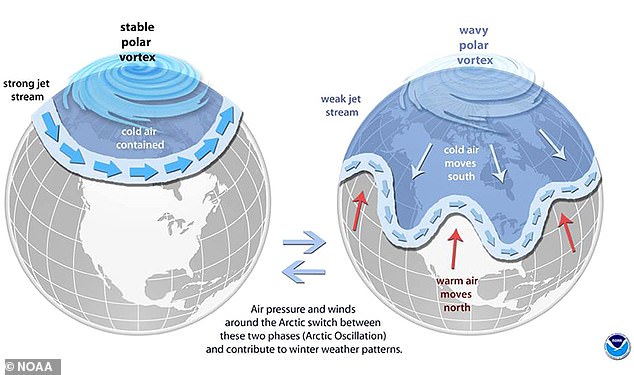Tag: PolarVortex
Brace yourself for a brutal winter: Experts say disruptions in the polar vortex could cause temperatures to plummet in parts of the US
- Polar vortex is an atmospheric circulation pattern that sits high above the poles
- Warm air moving into the Arctic can cause it to weaken and split into vortices
- These can bring colder temperatures and extreme weather to mid-latitudes
- Experts say split at the end of this month could cause severe weather in US
- The effects would likely come later in January and early February, experts say
The Eastern United States could be in for a blast of frigid weather.
Activity in an Arctic climate pattern could send the polar vortex barreling towards more southern latitudes to envelop parts of North America, Europe, and Asia.
The phenomenon has led to extreme winter weather in recent years, including record low temperatures in the US back in 2014 and last year’s ‘Beast from the East’ in the UK.
While there’s still time for things to change, the models currently suggest a split in the high-altitude polar vortex will ring in the New Year, creating the potential for ‘more severe winter weather’ in the Eastern US in the weeks to follow.
The latest predictions come from Dr Judah Cohen, of Atmospheric and Environmental Research (AER), and are supported by models from several other researchers shared in the last few weeks.
The polar vortex is an atmospheric circulation pattern that sits high above the poles, in a layer of the atmosphere called the stratosphere.
This structure can weaken as a result of abnormal warming in the poles, causing it to split off into smaller ‘sister vortices’ that may travel outside of their typical range.
As of the end of December, the models show the polar vortex situated above Scandanavia could break apart to become two or even three vortices, bringing colder weather to the mid-latitudes and warmer weather in the Arctic.
An animation shared on Twitter by meteorological scientist Michael Ventrice shows just what this might look like.
According to Cohen, ‘a stratospheric PV displacement or split is looking more and more likely during the last week of December and into the first week of January.’

As of the end of December, the models show the polar vortex situated above Scandanavia could break apart to become two or even three vortices, bringing colder weather to the mid-latitudes and warmer weather in the Arctic
Read more via DailyMailUK


